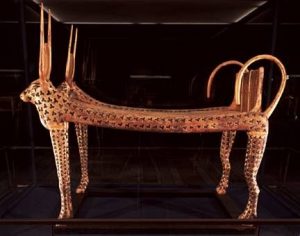Egyptian furniture provides almost the only surviving examples of actual ancient furniture. Egyptians believed that possessions could still be used in the afterlife, and items of furniture were buried with the dead in sealed tombs. In the hot, dry climate of Egypt, many items were preserved through the centuries to become fascinating and valuable museum pieces today.

Tomb of Queen Hetepheres
Reconstructions of artefacts found in the tomb of Queen Hetepheres have revealed an elaborate canopy bed, a carrying chair, and other items including numerous boxes.
Tomb of Tutankhamen
The tomb of Tutankhamen contained artefacts designed specifically for the burial site: his funerary couch, for example, is carved in the form of Ammit, the eater of the dead, a god with the head of a crocodile, the body of a leopard, and the hindquarters of a hippopotamus.
The Ancient Egyptians did not have much furniture. The most common item of furniture was a low stool, although many people, especially the poor sat on the floor. Rich people had beds and mattresses, while poorer people slept on a straw mattress or rug on the floor. The Ancient Egyptians did not have cupboards but stored things in reed baskets.
Stools have been found in houses and in Pharaohs’ tombs. Other ancient Egyptian furniture includes boxes, beds, oil lamps, and chests. Chests were used for storing clothing. Boxes were used to store jewellery and cosmetics.
In the second half of the Old Kingdom, chairs with arms and backs began appearing. Large size tables were rare. Egyptian furniture designs of this age often incorporated metal work. Also, inlay was increasingly used, as well as relief carving, and gilding.
By the New Kingdom, Egyptian furniture was highly prized and was often sent as tribute to the rulers of neighbouring countries. Fragments of Egyptian furniture have been excavated at sites around Western Asia.
Scribes even had boxes in which they stored their writing implements and palette. Their boxes were usually painted to imitate the stringing and veneered panels found on more ornate boxes.
The Egyptian bed was a rectangular wooden frame with a mat of woven cords. Instead of using pillows, the Egyptians used a crescent-shaped headrest at one end of the bed. Beds were made of a woven mat placed on wooden framework standing on animal-shaped legs.
One stool that became very popular in the Middle Kingdom (2000-1630 B.C.E.) was the folding stool, which probably had its origins in the military as a portable camp stool. Because of the military association, the folding stool became a status symbol, says Sibal, and wealthy homes featured stools with elaborately inlaid decorations of graceful animal figures, such as ducks.